小学三年级英语下册句型与语法归纳
- 格式:docx
- 大小:16.90 KB
- 文档页数:5
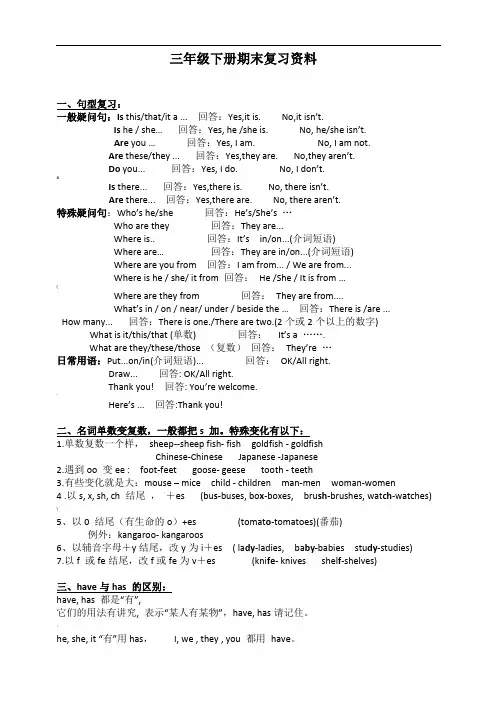
三年级下册期末复习资料一、句型复习:一般疑问句:Is this/that/it a ... 回答:Yes,it is. No,it isn’t.Is he / she…回答:Yes, he /she is. No, he/she isn’t.Are you …回答:Yes, I am. No, I am not.Are these/they ... 回答:Yes,they are. No,they aren’t.Do you... 回答:Yes, I do. No, I don’t.&Is there... 回答:Yes,there is. No, there isn’t.Are there... 回答:Yes,there are. No, there aren’t.特殊疑问句:Who’s he/she 回答:He’s/She’s…Who are they 回答:They are...Where is.. 回答:It’s in/on...(介词短语)Where are…回答:They are in/on...(介词短语)Where are you from 回答:I am from... / We are from...Where is he / she/ it from 回答:He /She / It is from …(Where are they from 回答:They are from....What’s in / on / near/ under / beside the …回答:There is /are ...How many... 回答:There is one./There are two.(2个或2个以上的数字) What is it/this/that (单数) 回答:It’s a …….What are they/these/those (复数)回答:They’re …日常用语:Put...on/in(介词短语)... 回答:OK/All right.Draw... 回答: OK/All right.Thank you! 回答: You’re welcome.'Here’s ... 回答:Thank you!二、名词单数变复数,一般都把s 加。

三年级下册英语句型与语法归纳1. 简单句型- 主语 + 谓语动词- 例句:I play football.- 主语 + 谓语动词 + 宾语- 例句:She eats an apple.- 主语 + 谓语动词 + 地点状语- 例句:We swim in the pool.2. 陈述句和疑问句- 陈述句:以陈述事实或描述情况。
- 例句:He is reading a book.- 一般疑问句:通过倒装将句子变成疑问形式。
- 例句:Is he reading a book?3. 动词的时态- 现在时:表示现在正在进行的动作或状态。
- 例句:She reads a book.- 过去时:表示过去发生的动作或状态。
- 例句:She read a book yesterday.- 将来时:表示将来会发生的动作或状态。
- 例句:She will read a book tomorrow.4. 形容词和副词- 形容词:用来描述名词或代词。
- 例句:She is a tall girl.- 副词:用来修饰动词、形容词或其他副词。
- 例句:She runs quickly.5. 介词- 介词用于表示位置、方向、时间等关系。
- 例句:The cat is on the table.6. 人称代词- 用于替代人或事物。
- 例句:I like ice cream.7. 句子的衔接- 使用连词(and, but, so等)来连接句子或短语。
- 例句:I like apples and bananas.8. 祈使句- 用于表达请求、命令等。
- 例句:Close the door, please.9. 疑问词- 用于提问,如who, what, where, when, why, how等。
- 例句:Where is the nearest supermarket?10. 句型转换- 可以通过改变句子结构或词序来改变句子的意思。
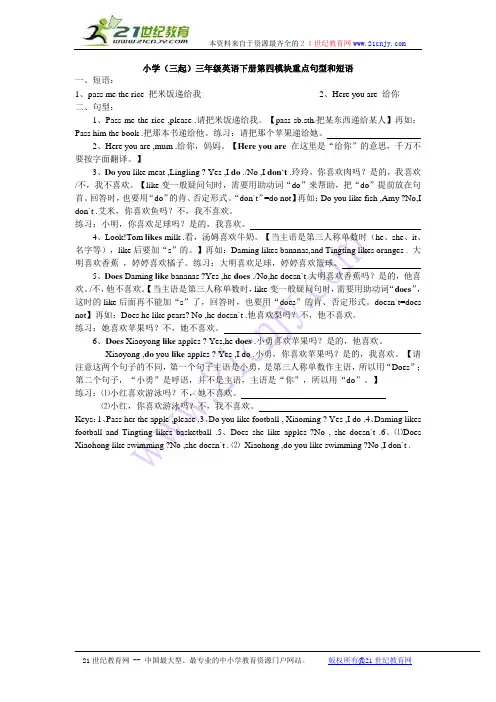
本资料来自于资源最齐全的21世纪教育网21世纪教育网 -- 中国最大型、最专业的中小学教育资源门户网站。
版权所有@21世纪教育网 小学(三起)三年级英语下册第四模块重点句型和短语一、短语:1、pass me the rice 把米饭递给我2、Here you are 给你二、句型:1、Pass me the rice ,please .请把米饭递给我。
【pass sb.sth.把某东西递给某人】再如:Pass him the book .把那本书递给他。
练习:请把那个苹果递给她。
2、Here you are ,mum .给你,妈妈。
【Here you are 在这里是“给你”的意思,千万不要按字面翻译。
】3、Do you like meat ,Lingling ? Yes ,I do ./No ,I don`t .玲玲,你喜欢肉吗?是的,我喜欢/不,我不喜欢。
【like 变一般疑问句时,需要用助动词“do ”来帮助,把“do ”提前放在句首。
回答时,也要用“do ”的肯、否定形式。
“don`t ”=do not 】再如:Do you like fish ,Amy ?No,Idon`t .艾米,你喜欢鱼吗?不,我不喜欢。
练习:小明,你喜欢足球吗?是的,我喜欢。
4、Look!Tom likes milk .看,汤姆喜欢牛奶。
【当主语是第三人称单数时(he 、she 、it 、名字等),like 后要加“s ”的。
】再如:Daming likes bananas,and Tingting likes oranges . 大明喜欢香蕉 ,婷婷喜欢橘子。
练习:大明喜欢足球,婷婷喜欢篮球。
5、Does Daming like bananas ?Yes ,he does ./No,he doesn`t 大明喜欢香蕉吗?是的,他喜欢。
/不,他不喜欢。
【当主语是第三人称单数时,like 变一般疑问句时,需要用助动词“does ”,这时的like 后面再不能加“s ”了,回答时,也要用“does ”的肯、否定形式。
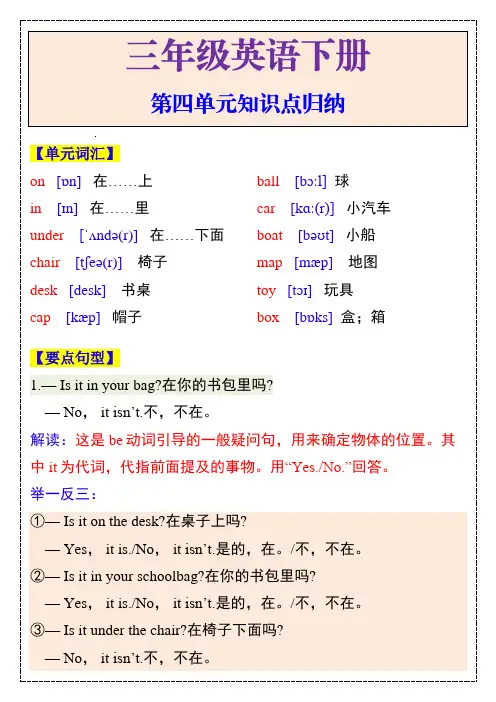
2.Where is my cap?我的帽子在哪儿?
解读:“Where + be动词 + 名词/代词?”用来询问物品在哪儿。
3.Have a good time!玩儿开心点儿!
解读:这是给出门旅行或者参加活动的人道别的时候所说的话。
【读一读,背一背】
1. Let’s go home! OK!我们回家吧!好的!
2. Where is my pencil box? 我的铅笔盒呢?
3. Look!It’s in your desk. 看!它在你的书桌里。
4. And your pencil! It’s under your book!你的铅笔,它在你的书下面。
5. Silly me! 我真傻!
6. Where is my map?我的地图在哪儿?
7. Is it in your bag? No,it isn’t.它在你的包里吗?不,它不在。
8. Is it in your toy box? Yes,it is. 它在你的玩具箱里吗?是的,它在。
9. Have a good time!玩得开心点儿!。

三年级下册英语句型与语法归纳在三年级下册的英语学习中,学生将继续掌握更多的句型和语法知识。
这些知识将帮助他们构建正确的句子,表达自己的意思。
下面是对三年级下册英语句型与语法的详细介绍。
一、句型:1. 主语 + be动词 + 形容词这个句型用来描述人或物的状态或特征。
例如:- He is tall.(他高)- The flower is beautiful.(花很漂亮)2. 主语 + 动词 + 宾语这个句型用来表示主语做了某个动作。
例如:- She reads a book.(她读书)- We eat dinner.(我们吃晚饭)3. 主语 + 动词 + 地点副词这个句型用来表示主语在某个地方做某个动作。
例如:- He swims in the pool.(他在游泳池里游泳)- They play soccer on the field.(他们在 ** 上踢足球)4. 主语 + 动词 + 时间副词这个句型用来表示主语在某个时间做某个动作。
例如:- I brush my teeth in the morning.(我早上刷牙)- They watch TV in the evening.(他们晚上看电视)5. 主语 + 动词 + 助动词 + 不定式这个句型用来表示主语将要做某个动作。
例如:- She is going to study for the test.(她准备要为考试学习)- We are going to visit the zoo.(我们打算要去动物园)6. 主语 + can + 动词这个句型用来表示主语具有某种能力。
例如:- He can swim.(他会游泳)- They can play the piano.(他们会弹钢琴)二、语法:1. 一般现在时这是最基本的时态,用来表示经常或一直发生的事情。
句子中的动词要用原形。
例如:- She likes ice cream.(她喜欢冰淇淋)- We go to school every day.(我们每天去上学)2. 现在进行时这个时态用来表示现在正在发生的事情。
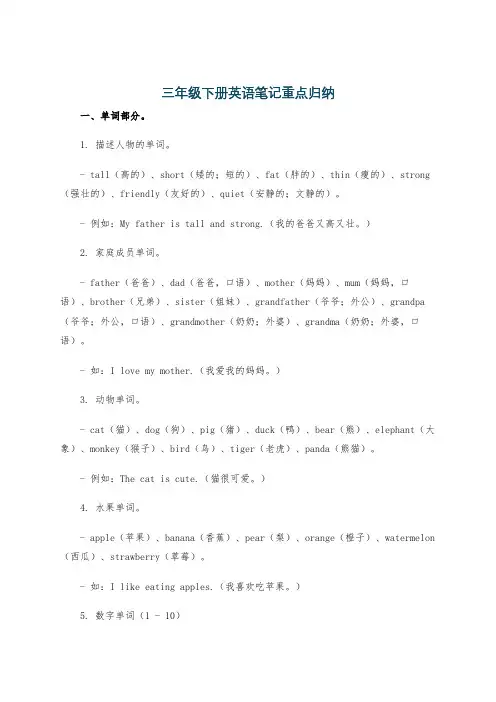
三年级下册英语笔记重点归纳一、单词部分。
1. 描述人物的单词。
- tall(高的)、short(矮的;短的)、fat(胖的)、thin(瘦的)、strong (强壮的)、friendly(友好的)、quiet(安静的;文静的)。
- 例如:My father is tall and strong.(我的爸爸又高又壮。
)2. 家庭成员单词。
- father(爸爸)、dad(爸爸,口语)、mother(妈妈)、mum(妈妈,口语)、brother(兄弟)、sister(姐妹)、grandfather(爷爷;外公)、grandpa (爷爷;外公,口语)、grandmother(奶奶;外婆)、grandma(奶奶;外婆,口语)。
- 如:I love my mother.(我爱我的妈妈。
)3. 动物单词。
- cat(猫)、dog(狗)、pig(猪)、duck(鸭)、bear(熊)、elephant(大象)、monkey(猴子)、bird(鸟)、tiger(老虎)、panda(熊猫)。
- 例如:The cat is cute.(猫很可爱。
)4. 水果单词。
- apple(苹果)、banana(香蕉)、pear(梨)、orange(橙子)、watermelon (西瓜)、strawberry(草莓)。
- 如:I like eating apples.(我喜欢吃苹果。
)5. 数字单词(1 - 10)- one(一)、two(二)、three(三)、four(四)、five(五)、six (六)、seven(七)、eight(八)、nine(九)、ten(十)。
- 例如:I have three pens.(我有三支钢笔。
)6. 方位介词。
- in(在……里面)、on(在……上面)、under(在……下面)、near(在……附近)。
- 例如:The book is on the desk.(书在桌子上。
)二、句型部分。

1. 介词“on…” “in…”的短语 on the chair/in the pencil-box/in the desk/in the bag/in the sky 2. 特殊疑问句“where”“what”“who”的⽤法 ①特殊疑问句“where”的⽤法: Where is …? ----It‟s on…. / It‟s in…. ②特殊疑问句“what”的⽤法: What‟s on the table? — A plate of cakes. ③特殊疑问句“who”的⽤法:. Who is he/she? He/ She is…. They are brother and sister. 当不知道是谁时,⼈称代词⽤it: Who is it? ----- It‟s me. 3. 感叹句⽤what和how: what修饰名词;how修饰形容词 How nice on a ship! How nice! What a fine day! What a big cake! 4.let’s 句型: let‟s =let us Let‟s make a blouse/vest. Let‟s run a race. /Let‟s play games. Let‟s ride it. Let‟s give her nice things. Let‟s sing“Happy Birthday to You”. Let‟s count the candles. Let me help you. Let me open/close the door. Let me get the apples/pears. Let‟s go home. 5. can句型: We can‟t let him in. She can’t swim. I can‟t find/see…. Can she swim? Yes, she can. / No, she can’t. Can you make cakes? Yes, I can. / No, I can‟t. Can you fly it? —Of course,I can. 6.主语是单数第三⼈称,谓语动词加“s”: look like 看起来像 She looks like Steve. Steve is Eve’s brother. I like him, and he likes me. 7.“have”的⽤法: ①“have”表⽰“有” I have a kite/ a new bike. We have some nice things for you. ②“have”表⽰“吃” Have a coke/an apple. —Yes, thank you./ No, thanks. Please have the cake. —Thank you. Let‟s have the good things.。

三年级下册英语总复习知识点一、语法1. 用 am/is/are 表示现在进行时。
例如:I am playing basketball. He is watching TV.2. 用can/can’t 表示能力。
例如:I can swim. He can’t play the guitar.3. 用 have/has 表示已完成的动作。
例如:I have finished my homework. He has done his project.4. 用连词 and/or 表示并列关系。
例如:I like apples and bananas. You can choose red and/or blue.5. 用 some/any 表示数量。
例如:I want some water. Do you have any questions?二、词汇1. 数字:one, two, three, four, five, six, seven, eight, nine, ten2. 颜色:red, yellow, blue, green, purple, black, white, orange3. 动物:elephant, lion, giraffe, monkey, rabbit, bird, fish, turtle4. 食物:hamburger, pizza, chicken, noodles, sandwich, egg, apple, banana5. 学科:Chinese, English, math, science, art, music, PE三、句型1. What’s this/that?(这/那是什么?)2. It’s a/an _______.(这/那是一份_________.)3. Do you like _______?(你喜欢_________吗?)4. Yes, I do./No, I don’t.(是的,我喜欢。
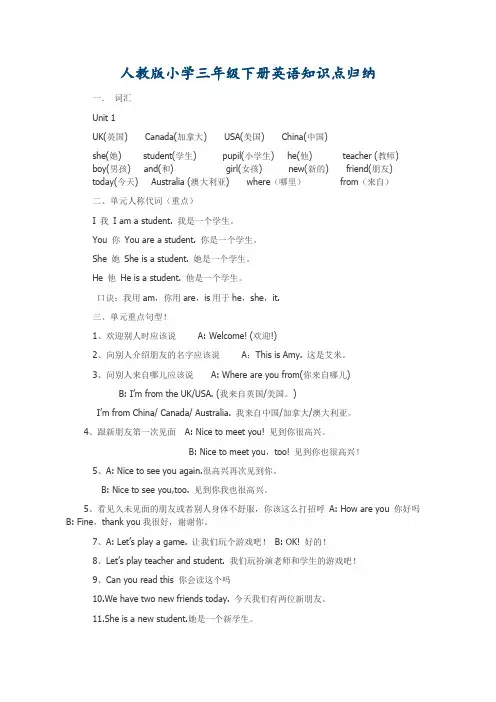
人教版小学三年级下册英语知识点归纳一.词汇Unit 1UK(英国) Canada(加拿大) USA(美国) China(中国)she(她) student(学生) pupil(小学生) he(他) teacher (教师)boy(男孩) and(和) girl(女孩) new(新的) friend(朋友)today(今天) Australia (澳大利亚) where(哪里)from(来自)二、单元人称代词(重点)I 我I am a student. 我是一个学生。
You 你You are a student. 你是一个学生。
She 她She is a student. 她是一个学生。
He 他He is a student. 他是一个学生。
口诀:我用am,你用are,is用于he,she,it.三、单元重点句型!1、欢迎别人时应该说A: Welcome! (欢迎!)2、向别人介绍朋友的名字应该说A:This is Amy. 这是艾米。
3、问别人来自哪儿应该说A: Where are you from(你来自哪儿)B: I’m from the UK/USA. (我来自英国/美国。
)I’m from China/ Canada/ Australia. 我来自中国/加拿大/澳大利亚。
4、跟新朋友第一次见面A: Nice to meet you! 见到你很高兴。
B: Nice to meet you,too! 见到你也很高兴!5、A: Nice to see you again.很高兴再次见到你。
B: Nice to see you,too. 见到你我也很高兴。
5、看见久未见面的朋友或者别人身体不舒服,你该这么打招呼A: How are you 你好吗B: Fine,thank you我很好,谢谢你。
7、A: Let’s play a game. 让我们玩个游戏吧!B: OK! 好的!8、Let’s play teacher and student. 我们玩扮演老师和学生的游戏吧!9、Can you read this 你会读这个吗10.We have two new friends today. 今天我们有两位新朋友。
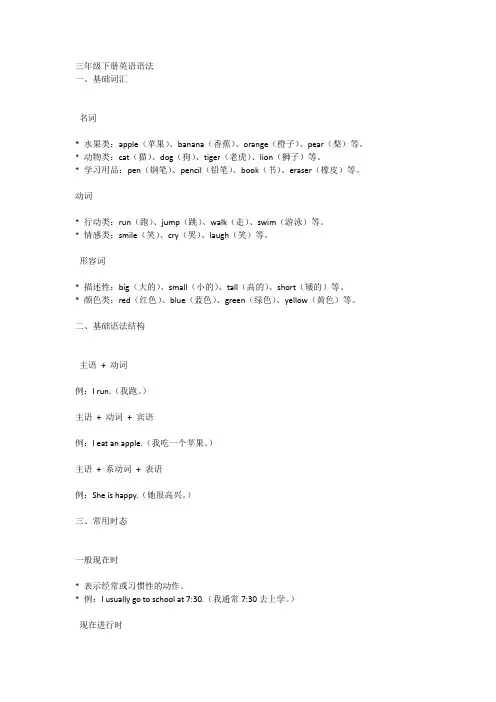
三年级下册英语语法一、基础词汇名词* 水果类:apple(苹果)、banana(香蕉)、orange(橙子)、pear(梨)等。
* 动物类:cat(猫)、dog(狗)、tiger(老虎)、lion(狮子)等。
* 学习用品:pen(钢笔)、pencil(铅笔)、book(书)、eraser(橡皮)等。
动词* 行动类:run(跑)、jump(跳)、walk(走)、swim(游泳)等。
* 情感类:smile(笑)、cry(哭)、laugh(笑)等。
形容词* 描述性:big(大的)、small(小的)、tall(高的)、short(矮的)等。
* 颜色类:red(红色)、blue(蓝色)、green(绿色)、yellow(黄色)等。
二、基础语法结构主语+ 动词例:I run.(我跑。
)主语+ 动词+ 宾语例:I eat an apple.(我吃一个苹果。
)主语+ 系动词+ 表语例:She is happy.(她很高兴。
)三、常用时态一般现在时* 表示经常或习惯性的动作。
* 例:I usually go to school at 7:30.(我通常7:30去上学。
)现在进行时* 表示正在进行的动作。
* 例:He is playing football now.(他现在正在踢足球。
)四、基础句型陈述句* 肯定句:主语+ 动词/系动词+ 其他。
* 否定句:主语+ 不/没+ 动词/系动词+ 其他。
疑问句* 一般疑问句:助动词/系动词+ 主语+ 动词/其他?* 特殊疑问句:疑问词+ 助动词/系动词+ 主语+ 动词/其他?感叹句* 表示强烈情感的句子,通常以what或how开头。
命令句* 表示命令或请求的句子,通常以动词原形开头。
五、常用短语和搭配* go to school(上学)* play football(踢足球)* have lunch(吃午饭)* watch TV(看电视)以上仅为三年级下册英语语法的基础内容,更详细的语法知识和实践练习,请结合教材和课堂教学进行。

3年级下册重点句型1. 过去时句型(1) 主语 + 动词过去式 + 其他例句:Yesterday, he played football with his friends inthe park.(昨天,他和他的朋友们在公园里踢足球。
)(2) What + 动词过去式 + 主语 + 动词过去式?例句:What did you do last weekend?(上个周末你做了什么?)2. 现在进行时句型(1) 主语 + am/is/are + 动词-ing + 其他例句:My sister is playing basketball in the school playground.(我的姐姐正在学校操场上打篮球。
)(2) 动词 + 主语 + am/is/are + 动词-ing?例句:Is he coming to the party tonight?(他今晚来参加派对吗?)3. 祈使句句型(1) 动词原形 + 其他例句:Listen to the teacher carefully.(认真听老师讲。
)(2) Don't + 动词原形 + 其他例句:Don't forget to bring your textbooks to school tomorrow.(明天别忘了带上你的课本来学校。
)4. There be句型(1) There is + 单数名词 + 其他例句:There is a cat under the table.(桌子下面有一只猫。
)(2) There are + 复数名词 + 其他例句:There are some apples in the basket.(篮子里有一些苹果。
)5. 一般疑问句句型(1) 助动词 + 主语 + 动词原形 + 其他?例句:Do you like ice cream?(你喜欢冰淇淋吗?)(2) 特殊疑问词 + 助动词 + 主语 + 其他?例句:What does your father do?(你爸爸是做什么工作的?)(3) 助动词 + 主语 + be动词 + 其他?例句:Is she your sister?(她是你的妹妹吗?)6. 反意疑问句句型(1) 主句 + , + 辅助动词 + 主语 + 动词原形 + 其他?例句:You can speak English, can't you?(你会说英语,对吗?)(2) 主句 + , + 辅助动词 + 主语 + 动词过去式 + 其他?例句:He went to the store, didn't he?(他去了商店,对吗?)以上是3年级下册的重点句型,希望同学们能够掌握并运用这些句型,提高英语表达能力。
Unit 1 Colours1.What's the matter? 你怎么了?I can't find my ball. 我找不到我的球了。
2. Is this your ball? 这是你的球吗?Yes,it is. 是的。
No, it isn’t. 不,不是。
3. What colour is the banana? 这根香蕉是什么颜色的?It is yellow. 它是黄色的。
What colour are the bananas? 这些香蕉是什么颜色的?They are yellow. 它们是黄色的。
4.Let's mix blue and yellow. 让我们把蓝色和黄色混合在一起。
Unit 2 Tastes1. What is it? It is a lemon. 它是什么? 它是一个柠檬。
How is it? It is sour. 它(的味道)如何?它是酸的。
2. Look at the apple. It’s red and round.看看这个苹果,它红红的、圆圆的。
3. Touch the apple. It’s smooth and hard.摸摸这个苹果,它滑滑的、硬硬的。
4. Smell the apple. It’s nice.闻闻这个苹果,它香香的。
5. Taste the apple. It’s sweet and juicy.尝尝这个苹果,它甜甜的、多汁的。
6. It is candy. 这是糖果It is a sweet.这是一个糖果。
Unit 3 Sounds1. Listen! What can you hear? 听!你能听到什么?I can hear a plane. 我能听到飞机的声音。
2. Look! What can you see? 看!你能看到什么?I can see a train. 我能看到一列火车。
3. Can you hear a dog?你能听到狗的声音吗?Yes, I can. 是的,我能听到。
新版译林小学英语三下知识点一、语法知识点:1. 一般现在时:表示现在经常性或习惯性的动作或状态,句子的主语为第三人称单数时,动词要加-s或-es。
2.一般过去时:表示过去发生的动作或存在的状态,动词过去式的构成规则。
3.现在进行时:表示现在正在进行的动作。
4. there be句型:表示处有物或人。
5.数词:基数词和序数词的用法。
6.名词复数形式:规则复数、不规则复数以及一些特殊名词的复数形式。
7.形容词比较级:表示两个人或事物之间的比较。
8.形容词最高级:表示三个或三个以上人或事物之间的最高级。
9.物主代词:表示所有关系。
10. 情态动词can的用法:表示能力、许可或请求。
11.人称代词的主格和宾格:主格用作主语,宾格用作宾语。
二、词汇知识点:1.人物、动物、植物等的名称。
2.数字、时间、日期等基本词汇。
3.季节、天气、颜色等基本词汇。
4.体育、娱乐、职业等基本词汇。
5.家庭成员、房间、家具等基本词汇。
6.学校、教室、学习用品等基本词汇。
7.食物、饮料、水果等基本词汇。
8.衣物、配件、颜色等基本词汇。
三、句型知识点:1. What's your/his/her name?:询问姓名。
2. How old are you/he/she?:询问年龄。
3. I/you/he/she/it/we/they am/is/are...:用于描述自己或他人的个人信息。
4. Do you like...? Yes, I do/No, I don't.:询问和表达喜欢或不喜欢的事物。
5. What color is it? It's...:询问和回答物品的颜色。
6. What's the weather like today?:询问今天天气如何。
7. What's your favorite...?:询问个人最喜欢的事物。
8. Can you...? Yes, I can/No, I can't.:询问和回答能力。
PEP小学英语三年级下册重点词汇和重点句型一、单词归类1.表示“一类人”boy 男孩girl 女孩teacher 教师student 学生man 男人woman 女人2. 表示问候good morning 早上好good afternoon 下午好3. 表示家庭成员father(dad)爸爸mother(mom)妈妈grandmother(grandma)奶奶grandfather(grandpa)爷爷sister 姐妹brother 兄弟4.表示数字eleven 11 twelve 12 thirteen 13 fourteen 14 fifteen 15sixteen 16 seventeen 17 eighteen 18 nineteen19 twenty 205.表示水果Peach桃子pear 梨orange 橙子watermelon 西瓜apple 苹果banana 香蕉strawberry 草莓grape 葡萄6.表示交通工具bus 公共汽车bike 自行车taxi 出租车jeep 吉普车boat 船plane 飞机7.表示位置on在……上面in在……里面under在……下面8.形容词small 小big 大long 长short 短tall 高short 矮9.房间里的物品desk 桌子chair 椅子walkman 随身听lamp 台灯window 窗户10.表示动物giraffe 长颈鹿zebra 斑马deer 鹿11.表示国家kangaroo袋鼠(澳大利亚)UK 英国USA 美国PRC 中国二、重点句型1.We have a new friend today.今天我们来了一位新朋友。
2.Where are you from? 你来自哪里?I’m from America /Canada /China. 我来自美国/加拿大/中国。
3.I’m sorry. 对不起。
It’s OK. Come in. 没关系。
人教版小学英语三年级下册知识点梳理(最新最全)Unit 1 At the zoo- 词汇:elephant, giraffe, panda, koala, lion, tiger, monkey, bird - 句型:What do you see? I see a/an ...Unit 2 Is this your pencil?- 词汇:pen, pencil, eraser, ruler, pencil case, schoolbag- 句型:Is this your ...? Yes, it is. / No, it isn't.Unit 3 How many bears?- 词汇:bear, monkey, rabbit, deer, elephant, panda- 句型:How many ... do you see? I see ... .Unit 4 What's the time?- 词汇:clock, time, hour, minute, half- 句型:What's the time? It's ... .Unit 5 Can I help you?- 词汇:map, book, hat, T-shirt, shoes, help- 句型:Can I help you? Yes, please. / No, thanks.Unit 6 Where's my schoolbag?- 词汇:desk, chair, window, door, blackboard, classroom, schoolbag- 句型:Where's my ...? It's ... .Unit 7 I like bananas.- 词汇:banana, apple, orange, pear, grape, watermelon- 句型:What fruit do you like? I like ... .Unit 8 What's in the park?- 词汇:swings, slides, seesaw, sandbox, park- 句型:What's in the park? There are ... .Unit 9 Our classroom- 句型:This is our ... .Unit 10 Happy birthday!- 词汇:birthday, cake, candles, present, happy- 句型:Happy birthday! This is for you. Thank you.以上是人教版小学英语三年级下册的所有知识点梳理,希望对小学三年级学生的学习有所帮助。
三年级第二学期牛津英语语法复习一.词1.名词专有名词(1)spring, summer, autumn, winter前不加the(2)Shanghai 等地名前不加the(3)Sun, cloud, wind前加the2.名词的复数形式可数名词变复数(1)一般情况在名词的词尾加”s”cow-----cows book-----bookss在清辅音音素如/k/, /p/等后发/s/,在浊辅音音素后如/g/,/b/,/l/,/m/等后面发/z/. (2)辅音字母+y结尾的闽此, 将y变成i加esfly------flies元音字母+y结尾的名词, 直接加“s”boy----boys day-----days(3)以s, x, ch, sh结尾的名词, 在词尾加esglass-----glasses box-----boxes词尾es发/iz/,如class(4)以f,fe结尾的名词, 有些在词尾直接加sroof-----roofs有些将f或fe改为v 再加esknife-----knives leaf-----leaves(5)不规则变化child------children man-----menfoot-----feet mouse-----micetooth------teeth(6)名词单复数同形Chinese sheep deer fish(1)3. 冠词a,an,the(2)an 用在元音因素的名词前面an apple(3)体育运动前不用theplay football(1)4.副词and,but(2)and表示和, 连接同类词red and blackbut表示转择, 意思发生变化I like it ,but it’s hot.5.情态动词can表示会, 能I can write.He can jump(1)can +动词原形6. 正反义词fat----- thin young-----old new-----old tall------short long-----short big-----small hot-------cold warm----cool wet-----dry smooth -----rough hard-----soft sour-----sweet 二.句型1.t.beThis is a book(复数)This is these areThat is those areIt is they are2.to haveI hehave she has You itthey xx3.there be(1)There is用于单数句和不可数名词(2)There are用于名次复数4. Like(1)like to+动词原形I like to sing.(2)like+动名词I like singing.第一、二人称用like, 第三人称用likesHe likes to eat fish(3)疑问句与否定句转换Do you like…..Does he like…I don’t like…..He doesn’t like…5.祈使句(1)动词原形, 第二人称主语you 一般省去Open the door!Don’t open the door(2)第一、三人称Let us/ Let’s/ Let+第三人称名词或代词+动词原形Let me go to schoolLet’s play football.6.特殊疑问句(1) what 什么Thi.i..book.. Wha.i.it?/Wha.ar.they? .lik.flowers.Wha.d.yo.like?M.nam.i.Jane.Wha.‘? It’.red.Wha.colou.i.it?It’.summer.Wha.seaso.i.it?It’.fiv.o’clock.Wha.tim.i.it?(2)who 谁H.i.Peter.... Wh.i.he?(3)which 哪一个which season do you like?(4)how 怎么How old are you ?/How old is he? How are you ?(4)where 哪里It’.o.th.desk.Wher.i.it?。
人教版三年级英语下册单元知识点及重点语法归纳复习资料Part1:三年级英语下册单元知识点Unit 1 Big or Small (大或小)【必背词汇】happy 快乐的tall 高的hot 热的big 大的sad悲伤的short短的cold冷的small小的hello 你好animal 动物good 好table 桌子they 他们or 或者and 和【重点句型】1.形容的状态(某人是…)用:人称代词+be动词+形容词.例句:Im big. 我是大的。
You’re big. 你是大的。
She’s small. 她是小的。
He’s small. 他是小的。
We’re happy. 我们是快乐的。
They’re cold. 他们是冷的。
2.不确定某人的状态(某人是…吗?)问:be动词+人+形容词?答:Yes, 人称代词+ is/are.No, 人称代词+is/ are not.例句:Are you happy ? - Yes, I am. / No, I am not.你是开心的吗? 是的,我是。
/ 不是的,我不是。
Are you sad? -Yes, we are. / No, we aren’t.你们是悲伤的吗?是的,我们是。
/ 不是的,我们不是。
Is she/ he tall? -Yes, she/he is. / No, she/ he isn’t.她/他是高的吗?是的她/他是。
/ 不是的,她/他不是。
Are they small? -Yes, they are. / No, they aren’t.他们是小的吗?是的,他们是。
/ 不是的,他们不是。
3.物体的状态也用同样的句形。
句型:单数/不可数名词+is +形容词。
例句:The table is small. It’s big.桌子是小的。
他是大的。
句型:复数+are +形容词。
例句:The apples are small. They’re big.苹果的是小的。
小学三年级英语下册句型与语法归纳
一、句型复习
一般疑问句:
Is this/that/it a ...? 回答:Yes,it is. No,it isn’t. Is he / she...? 回答:Yes, he /she is. No, he/she isn’t.
Are you...? 回答:Yes, I am. No, I am not.
Are these/they ...? 回答:Yes,they are. No,they aren’t. Do you...? 回答:Yes, I do. No, I don’t.
Is there...? 回答:Yes,there is. No, there isn’t. Are there...? 回答:Yes,there are. No, there aren’t.特殊疑问句:
Who’s he/she ? 回答:He’s/She’s ?
Who are they? 回答:They are...
Where is..? 回答:It’s in/on...(介词短语) Where are?? 回答:They are in/on...(介词短语) Where are you from? 回答:I am from...
/ We are from...
Where is he / she/ it from? 回答:He /She / It is from ? Where are they from? 回答: They are from....
What’s in / on / near/ under / beside the ?? 回答:There is /are ...
How many...? 回答:There is one./There are two.(2个或2个以上的数字)
What is it/this/that? (单数) 回答:It’s a... . What are they/these/those? (复数)回答:They’re ...
日常用语:
Put...on/in(介词短语)... 回答: OK/All right. Draw... 回答: OK/All right.
Thank you! 回答: You’re welcome.
Here’s ... 回答:Thank you!
二、名词单数变复数,一般都把s 加。
特殊变化有以下:
单数复数一个样,sheep--sheep fish- fish goldfish - goldfish Chinese-Chinese Japanese -Japanese
2.遇到oo 变ee : foot-feet goose- geese tooth - teeth
3.有些变化就是大:mouse –mice child - children man-
men woman-women
4 .以s, x, sh, ch 结尾,+es (bus-buses, box-boxes, brush-brushes,
watch-watches)
5、以0 结尾(有生命的o)+es (tomato-tomatoes)(番茄) 例外:kangaroo- kangaroos
6、以辅音字母+y结尾,改y为i+es ( lady-ladies, baby-babies study-studies)
7.以 f 或fe结尾,改f或fe为*+es (knife- kni*es shelf-shel*es)
三、ha*e与has 的区别:
ha*e, has 都是“有”,
它们的用法有讲究, 表示“某人有某物”,ha*e, has请记住。
he, she, it “有”用has,I, we , they , you 都用 ha*e。
主人单数用 has , 主人复数用 ha*e。
ha*e 就是能力强,疑问(?)否定(don’t / do not)都用它。
四、ha*e ,has 与there is , there are 的区别
表示某人或某动物有:has / ha*e (I ha*e a dog. The dog has a short tail.) 表示某地方有: there is / are (There is a book in the bag. )
五、Some与any 的区别:
some用于肯定句中,any用于否定句和疑问句中。
如:I ha*e some books. I don’t ha*e any books. Do you ha*e any books ?
六.a 与an 的区别
一般来讲,元音字母(即a, e , i, o , u )开头的单词用an
如:an apple an ear an American girl an Australian stamp an old man
七. There be 句型(即 there is / there are )
意思:表示某地方有某人或某物原则:就近原则(There be 句型中的be 动词用is 还是用are 由最靠近它的第一个名词是单数还是复数决定。
)
如: There is a book and some pens on the desk. There are some pens and a book on the desk.
八.不可数名词:
juice chalk tissue (不可数名词没有复数形式)
There is some chalk. There is some juice. There is some tissue.
九.’s所有格:
表示:某人或某动物的
the girl’s name 那个女孩的名字the teacher’s desk 讲台
the headmaster’s office 校长的办公室the children’s toys 儿孩子们的玩具
the teachers’ room 教师办公室(当名词的复数形式是以“s”结尾时,直接加’)
十. be 动词 :
is are am (表示“是” )
I 用am , you 用are , is 连着he,she ,it 。
单数名词用is ,复数名词全用are 。
如:I am …. You are… . We are… . They are…. . He is….. She is….. It is…. The girl is …. The boys are…. Ben is…. Janet and Ben are…
网络搜集整理,仅供参考。